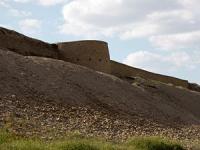You are here
Old Serakhs fortress.

Automobile routes across Turkmenistan.
Patches of thick woodland round Tedzhen, three hours east of Ashkhabad, hint at how the oases of the southern Kara-Kum must once have been; but here and at Mary cotton plantation and concrete irrigation canals have virtually taken over.
Don’t break journey in Tedzhen unless you want to visit Serakhs, 90 km south on the upper Tedzhen river. A kilometre from its twin of the same name over the Iranian border, Serakhs flourished as a Silk Route oasis until the Mongols destroyed all of it bar the XI century Abul Fazl mausoleum, now restored.
Exactly eleven centuries later Colonel F.M. Bailey nearly perished at Sarakhs in a border skirmish with Red Guards only yards from the safery of British-controlled Iran after his epic flight across the desert from Bukhara.
The mausoleum of Abul Fazl,a Sufi mystic who died in 1023, was built by the architect responsible for the Sultan Sanjar mausoleum in Merv,and stands 3 km south of modern Sarakhs beside an unexcavated mound which was the shahristan or citadel. It is a holy place.
About 10 km further south, near a reservoir used for swimming, the ruined portico of the Ahmed al-Khadin mausoleum (also XI century) must be the lonelist, southern-most Silk Route. Serahs oasis, situated between Nishapur and Merv was one of the important points on the way of the Great Silk Route.
The significance of Serahs increased after the Arabs' invasion. It was in those days that the direction of one of the main routes of the Great Silk Road has been changed; now it led from the central areas of Iran to Nishapur and from there, across Serahs, to Merv and further to the east.
The XIth century is marked by the formation of a strong Turkmen state with the dynasty of Great Seidjuks at the head, who left a brilliant mark in the history of Middle and Near East people.Creation of two and even three - layered dome constructions became a remarkable achievement of the architectural style of the Seraks architecture.
The Seraks fortress became an important town, surrounded with clay (paksha) walls with towers and moats. In XI - XII c.c. the town presented a citadel.
Authority:
On materials of information department of the State committee of Turkmenistan on tourism and sport. "Religious and spiritual monuments to Central Asia". Author M. Hashimov. Saga publishing house, 2001.







